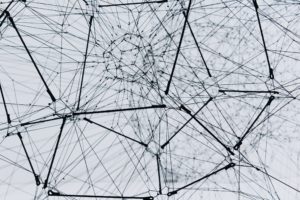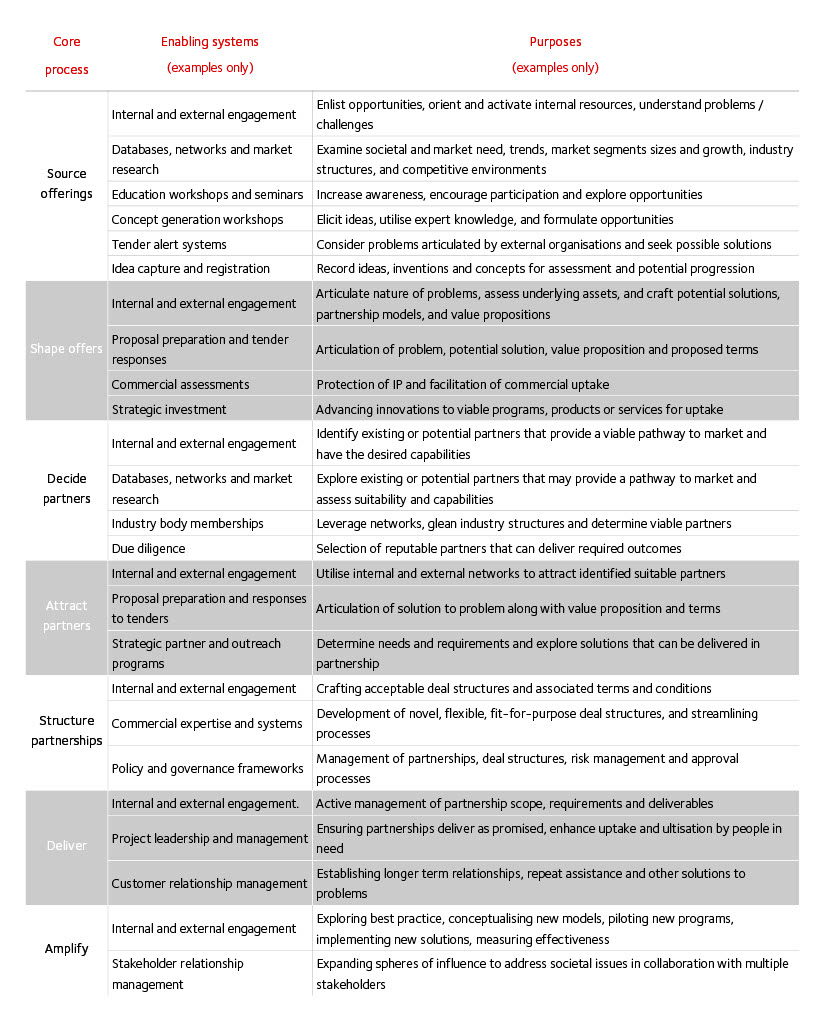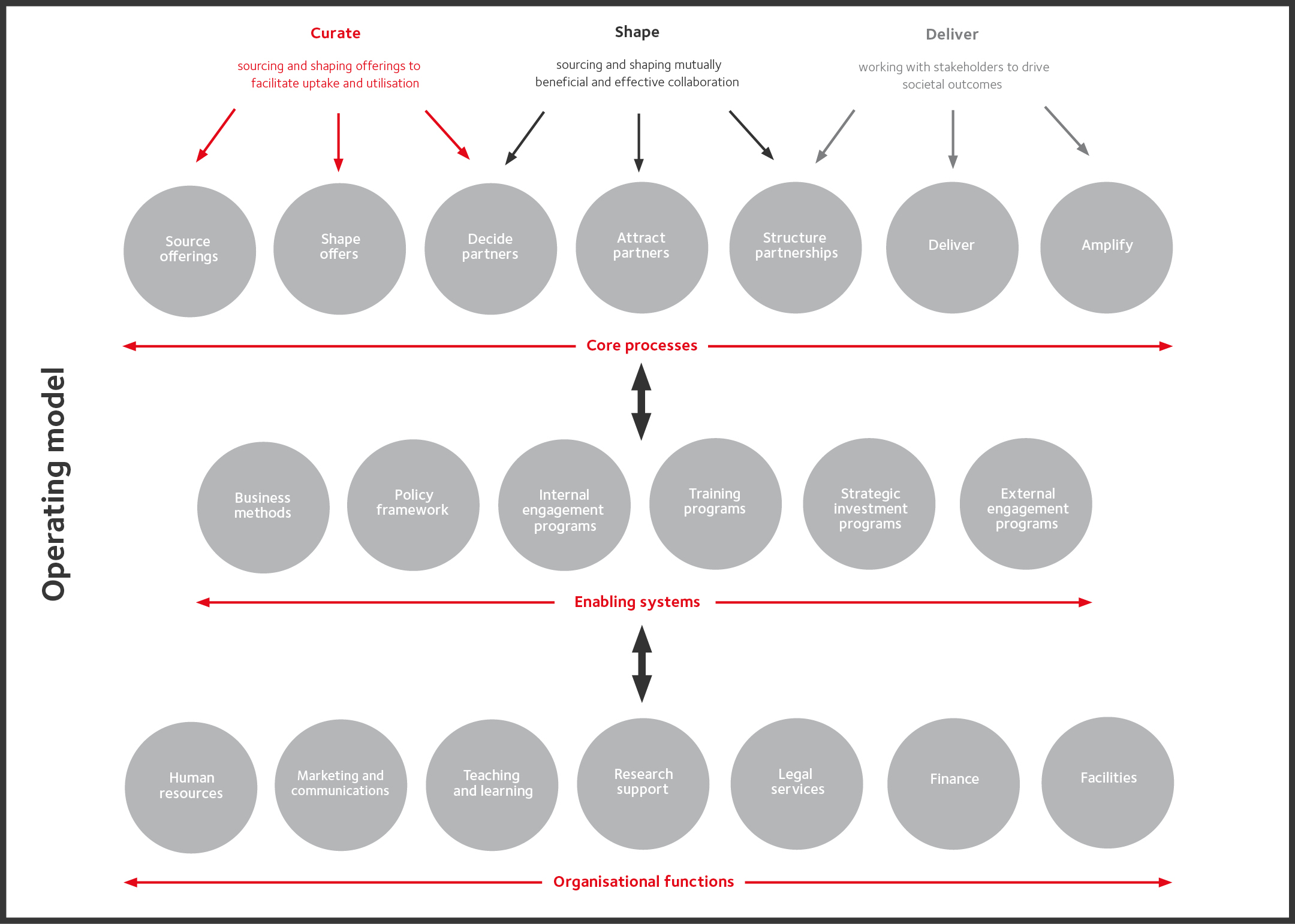This is Section 9 of the series on the topic of deriving impact from universities in the 21st century, authored by Nicholas Mathiou, Director of Griffith Enterprise.

“Coming together is a beginning; keeping together is progress; working together is success.”
– Henry Ford, Industrialist and business magnate, 1863-1947
9. Operating model
Introduction
For a university to successfully deliver socio-economic impact, it must establish a sound organisational direction through the turbulence and uncertainty of today’s dynamic environments. However, not only must a university do the right things, it must also do things right. To meet this challenge, it must also have the right organisational character.
A key initial step in developing organisational character is the articulation of the ‘critical proficiencies’ needed by a university to bring about great societal outcomes (as established in section 6). In essence, to derive impact, universities must become proficient at sourcing and shaping offerings, entering into mutually beneficial engagements, and working with partners and collaborators to maximise the benefits from those engagements (‘critical proficiencies’). This act of determining what a university needs to be great at doing to achieve its organisational direction shapes the required ‘organisational character’.
In sections 7 and 8 of this series we canvassed the engagement model and how a university directs internal and external engagement activities through certain channels to get things done. In this section, continuing on the theme of getting things done by consistently working together, the role of the operating model is detailed, commencing with the components and a working definition of the concept.
Components of operating model
Each university incorporates its own unique and complex system in its endeavour to deliver value. For larger institutions with a broad or diverse range of elements and disciplines, the complexity may be multiplied significantly. An operating model is a complicated, multidimensional concept and this series does not cover all of the aspects involved. Rather, with a singular focus on the university sector, the following definition will be utilised: A description of the processes, systems and functions required to deliver value to stakeholders.
Similar to other concepts previously detailed in this series, we propose that for universities to derive impact successfully, their operating models must be consistent with overall organisational direction (see sections 2-5 of this series) and must support critical proficiencies (section 6). There are three key components of an operating model to derive impact from universities: (i) ‘core processes’, (ii) ‘enabling systems’ and (iii) ‘organisational functions’.

Core processes are the key actions required to deliver great societal impact. Core processes must be aligned with the critical proficiencies and represent the linked actions required to derive societal impact.
Enabling Systems are the activities, programs and methods (‘resources’) that ‘enable’ the core processes to deliver value.
Organisational functions are those areas within a university that provide the necessary professional services to support enabling systems and operations.
We next start to assemble an operating model for universities, turning first to the alignment of core processes with the critical proficiencies, then to some of the associated enabling systems, before briefly touching on various organisational functions (with which readers will be familiar).
How core processes fit in
An operating model capable of deriving impact from a university should in essence involve several interconnected core processes as illustrated and elaborated upon below.

The curation of opportunities, involves three key actions: sourcing offerings, shaping potential offers and identifying potential partners (a key component of deciding which partners to work with) that can help to address a societal issue. Consistent with a university’s organisational direction, a key objective is to ensure education programs, products or services get utilised by as many people in need as possible. And, as proposed in section 3 of this series (‘Spheres of Impact’) partnerships are required to achieve this objective.
The shaping of partnerships involves three key actions: determining which of the identified partners to target (based on opportunities and the overarching organisational direction), attracting those partners to opportunities and offerings and structuring enduring partnerships capable of delivering the education programs, products or services to as many people in need as possible.
The delivery of societal outcomes involves those actions that enable universities to work successfully in partnership to ensure as many people in need as possible receive the benefits of the programs, products or services. These actions involve delivering the education programs, products or services as agreed, working together with partners to deliver intended outcomes and scaling collaborations to ensure as many people in need as possible receive the associated benefits.
How enabling systems fit in
Enabling systems that support the core processes are likely to be diverse from university to university, but most can be grouped into the following major categories illustrated below.

Business methods help university staff undertake their various roles and meet their university’s objectives and therefore are critical to success. Business methods are often fit-for-purpose and proprietary. They can contribute to competitive advantage by bringing together things like strategy, people and roles, structures and responsibilities, systems and procedures.
A policy framework is required to enable supportive activities to occur across complex organisational structures. The policy framework must signal intent. It incentivises and rewards staff for the achievement of organisational direction, establishes governance (including risk mitigation), directs procedures (including approvals for resource allocation and partnering) and establishes expected conduct. Policies can be diverse but when framed with organisational direction are critical to galvanising aligned activities.
Building internal relationships and awareness of capabilities across an organisation and the resultant exploration of opportunities that include the full gamut of underlying assets and potential partners is driven by internal engagement activities (detailed in sections 7 and 8 of this series).
Supplementing internal engagement activities, and with a view to driving next-generation derivation of impact, are various training programs in the form of internal education workshops and seminars. These are integral to encouraging participation and equipping staff with the skills to curate opportunities, shape partnerships and deliver outcomes. Many leading programs run by universities provide hands-on experience at the same time as curating opportunities.
Often strategic investment is required by universities to advance various innovations or opportunities to a stage where they are ready to be advanced with partners. This involves a professional application, evaluation and approval process for investment, followed by active monitoring and business development with a view to advancing to a partnership. Many universities introduce specialist proof-of-concept and early-stage investment capability and innovative funding models to support the curation of opportunities.
The building of relationships with external organisations and awareness of their capabilities is crucial to the exploration of holistic solutions to societal challenges together with potential partners, and is achieved through external engagement programs (detailed in sections 7 and 8).
The following table, provides some examples of the types of enabling systems that support the core processes required to derive impact from universities[1].
Examples of Enabling Systems Supporting Core Processes

For large and diverse universities with complex organisational structures, the engagement model and operating model must function together. When shaped around the critical proficiencies required to successfully derive impact, they complement each other.
Organisational functions
Organisational functions involve the many areas of an organisation that provide professional services internally. They are likely to be very diverse from university to university, but most can be grouped into the following broad, recognisable categories.

Whilst it is beyond the remit of this series to delve into all the organisational functions of universities, a few matters pertinent to this section of this series should be noted. First, the allocation of resources from each organisational function is best coordinated through a common understanding across the university business of critical proficiencies and core processes so that resources are directed toward the achievement of organisational direction. Ensuring this understanding occurs across the full spectrum of organisational functions requires purposeful engagement (sections 7 and 8) and strategic communication (a forthcoming topic of this series).
Second, universities are a ‘people’ business and each organisational function comprises of people. Many roles are highly specialised and it takes many different aptitudes and experiences to operate a university effectively. The operating model, accordingly, demonstrates how and why the attraction, development, motivation, deployment, management and satisfaction of high-calibre staff is core to universities’ successes. Further, team structures and the ways that people work together are also clearly critical to success, and this extends and applies to specialist groups within universities that support the teaching and learning and research agendas. Good people can make organisational functions work if they are aligned with a university’s organisational direction and they keep the associated critical proficiencies at the core of what they do.
Establishing an operating model
An operating model that supports a university’s organisational direction, and which is designed around the critical proficiencies enhances the likelihood of deriving impact. The fundamental components of an operating model for a university are summarised below:

Continually asking the following questions helps universities design and establish an operating model capable of deriving impact:
Question 1: Do our core processes help curate opportunities, shape partnerships and deliver socio-economic benefit?
Question 2: Do our enabling systems provide the activities, programs and methods (‘resources’) that ‘enable’ the core processes to deliver value?
Question 3: Are the necessary professional services to support the core processes and enabling systems in place and aligned with critical proficiencies and core processes?
There are many universities that understand their environments, have a lock on important resources, employ finely-tuned service delivery processes and work hard at relationships with stakeholders in the ways we have put forward in this and the preceding two sections of this series. However, if these activities occur in isolation, universities still struggle to derive impact. This brings us to the third aspect of the organisational character required to deliver organisational direction in today’s ever changing environments – the ‘implementation model’, the aspect required to pull all elements into a cohesive whole. It is to this concept we now turn in Section 10.
Read the previous article from this series.

ABOUT THE AUTHOR: Nicholas Mathiou is Director of Griffith Enterprise, the innovation and enterprise office of Griffith University. He has extensive commercial experience, having established and grown innovation-based businesses and organisations. He is driven by an ambition to see great social dividends emerge through university-based innovation. He has a deep understanding of the unique challenges involved in advancing innovations within complex organisations and in dynamic environments.
[1] Many of these enabling systems will be elaborated upon in future series.
Introduction image credit: photo by Alina Grubnyak on Unsplash


